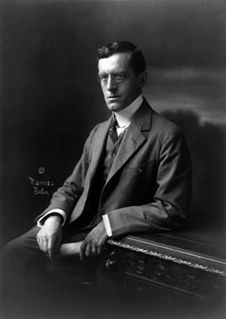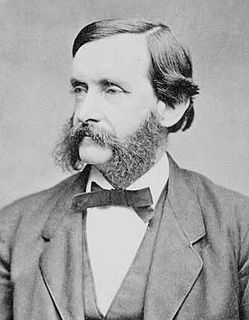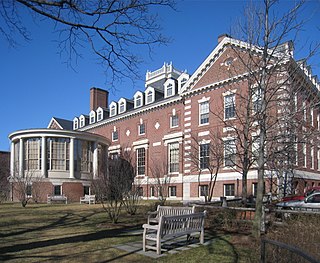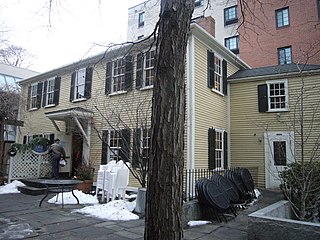
Ralph Adams Cram was a prolific and influential American architect of collegiate and ecclesiastical buildings, often in the Gothic Revival style. Cram & Ferguson and Cram, Goodhue & Ferguson are partnerships in which he worked. Together with the architect Richard Upjohn and artist John LaFarge, he is honored on December 16 as a feast day in the Episcopal Church of the United States. Cram was a fellow of the American Institute of Architects.

Harvard Stadium is a U-shaped college football stadium in the northeast United States, located in the Allston neighborhood of Boston, Massachusetts. The stadium is owned and operated by Harvard University and is home to the Harvard Crimson football program. The stadium's seating capacity is 30,323.

Beacon Hill is a historic neighborhood in Boston, Massachusetts, and the hill upon which the Massachusetts State House resides. The term "Beacon Hill" is used locally as a metonym to refer to the state government or the legislature itself, much like Washington, D.C.'s "Capitol Hill" does at the federal level.

Thomas Wentworth Higginson was an American Unitarian minister, author, abolitionist, and soldier. He was active in the American Abolitionism movement during the 1840s and 1850s, identifying himself with disunion and militant abolitionism. He was a member of the Secret Six who supported John Brown. During the Civil War, he served as colonel of the 1st South Carolina Volunteers, the first federally authorized black regiment, from 1862 to 1864. Following the war, Higginson devoted much of the rest of his life to fighting for the rights of freed people, women and other disfranchised peoples.

The Longfellow House–Washington's Headquarters National Historic Site is a historic site located at 105 Brattle Street in Cambridge, Massachusetts. It was the home of noted American poet Henry Wadsworth Longfellow for almost 50 years, and it had previously served as the headquarters of General George Washington (1775–76).

Elmwood, also known as the Oliver-Gerry-Lowell House, is a historic house and centerpiece of a National Historic Landmark District in Cambridge, Massachusetts. It is known for several prominent former residents, including: Thomas Oliver (1734–1815), royal Lieutenant Governor of Massachusetts; Elbridge Gerry (1744–1814), signer of the US Declaration of Independence, Vice President of the United States and eponym of the term "gerrymandering"; and James Russell Lowell (1819–1891), noted American writer, poet, and foreign diplomat.
There are three houses named the Harrison Gray Otis House in Boston, Massachusetts. All were built by noted American architect Charles Bulfinch for the same man, Federalist lawyer and politician Harrison Gray Otis.

Cambridge Common is a public park and National Historic Landmark in Cambridge, Massachusetts, United States. It is located near Harvard Square and borders on several parts of Harvard University. The north end of the park has a large playground. The park is maintained by the Cambridge Department of Public Works.

The Emily Dickinson Museum is a historic house museum consisting of two houses: the Dickinson Homestead and the Evergreens. The Dickinson Homestead was the birthplace and home from 1855 to 1886 of 19th-century American poet Emily Dickinson (1830–1886), whose poems were discovered in her bedroom there after her death. The house next door, called the Evergreens, was built by the poet's father, Edward Dickinson, in 1856 as a wedding present for her brother Austin. Located in Amherst, Massachusetts, the houses are preserved as a single museum and are open to the public on guided tours.

The William Dean Howells House is a house built and occupied by American author William Dean Howells and family. It is located at 37 Concord Avenue, Cambridge, Massachusetts. The house was designed by Howell's wife, Elinor Mead, and occupied by the family from 1873 to 1878. Authors including Mark Twain, Henry James, Henry Wadsworth Longfellow, and Thomas Bailey Aldrich visited the Howells in this house, as did President James Garfield, and Helen Keller lived there afterwards while attending school.

John Eliot Square District is a historic district located in the northern Roxbury neighborhood of Boston, Massachusetts. It is formed by the intersection of Dudley, Bartlett, Centre, Roxbury and Highland Streets. Named after local missionary to the Indians, John Eliot, the square was the site of the Roxbury town center after its founding in 1630. Roxbury was annexed to Boston in 1868, and John Eliot Square was added to the National Register of Historic Places in 1973. The square is the nucleus of Roxbury Heritage State Park, a history-themed heritage park.

The William Brattle House is an historic house in Cambridge, Massachusetts. It is one of the seven Colonial mansions described by historian Samuel Atkins Eliot as making up Tory Row. It remains in use by the Cambridge Center for Adult Education.

Harvard Union, now known as the Barker Center and once known as the Freshman Union, is a historic building on Quincy and Harvard Streets in Cambridge, Massachusetts.

The Dexter Pratt House is an historic house in Cambridge, Massachusetts. It is remembered as the home of Dexter Pratt, the blacksmith who inspired the poem "The Village Blacksmith" by Henry Wadsworth Longfellow.

The former First Unitarian Church is a historic church building at 130 Highland Avenue in Somerville, Massachusetts. The stone church was built in 1894 for a Unitarian congregation. It was designed by Hartwell & Richardson and is a good example of Richardsonian Romanesque design. The building presently (2022) houses the Mission Church of Our Lord Jesus Christ.

Fort Pickering is a 17th-century historic fort site on Winter Island in Salem, Massachusetts. Fort Pickering operated as a strategic coastal defense and military barracks for Salem Harbor during a variety of periods, serving as a fortification from the Anglo-Dutch Wars through World War II. Construction of the original fort began in 1643 and it saw use as a military installation into the 20th century. Fort Miller in Marblehead also defended Salem's harbor from the 1630s through the American Civil War. Fort Pickering is a First System fortification named for Colonel Timothy Pickering, born in Salem, adjutant general of the Continental Army and secretary of war in 1795. Today, the remains of the fort are open to the public as part of the Winter Island Maritime Park, operated by the City of Salem.

The New England Women's Club of Boston, Massachusetts, was one of the two earliest women's clubs in the United States, having been founded a couple of months after Sorosis in New York City.

Brattle Street in Cambridge, Massachusetts, called the "King's Highway" or "Tory Row" before the American Revolutionary War, is the site of many buildings of historic interest, including the modernist glass-and-concrete building that housed the Design Research store, and a Georgian mansion where George Washington and Henry Wadsworth Longfellow both lived Samuel Atkins Eliot, writing in 1913 about the seven Colonial mansions of Brattle Street's "Tory Row," called the area "not only one of the most beautiful but also one of the most historic streets in America." "As a fashionable address it is doubtful if any other residential street in this country has enjoyed such long and uninterrupted prestige."
Eastern Point Fort was a fort that was garrisoned or maintained from 1863 to 1867 on Eastern Point in Gloucester, Massachusetts, built for the American Civil War. References indicate the name has also been used to refer to the much-older Stage Fort across the harbor.

Fort Hill is a 0.4 square mile neighborhood and historic district of Roxbury, in Boston, Massachusetts. The approximate boundaries of Fort Hill are Malcolm X Boulevard on the north, Washington Street on the southeast, and Columbus Avenue on the southwest.





















